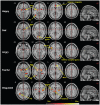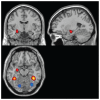Functional atlas of emotional faces processing: a voxel-based meta-analysis of 105 functional magnetic resonance imaging studies
- PMID: 19949718
- PMCID: PMC2783433
Functional atlas of emotional faces processing: a voxel-based meta-analysis of 105 functional magnetic resonance imaging studies
Abstract
Background: Most of our social interactions involve perception of emotional information from the faces of other people. Furthermore, such emotional processes are thought to be aberrant in a range of clinical disorders, including psychosis and depression. However, the exact neurofunctional maps underlying emotional facial processing are not well defined.
Methods: Two independent researchers conducted separate comprehensive PubMed (1990 to May 2008) searches to find all functional magnetic resonance imaging (fMRI) studies using a variant of the emotional faces paradigm in healthy participants. The search terms were: "fMRI AND happy faces," "fMRI AND sad faces," "fMRI AND fearful faces," "fMRI AND angry faces," "fMRI AND disgusted faces" and "fMRI AND neutral faces." We extracted spatial coordinates and inserted them in an electronic database. We performed activation likelihood estimation analysis for voxel-based meta-analyses.
Results: Of the originally identified studies, 105 met our inclusion criteria. The overall database consisted of 1785 brain coordinates that yielded an overall sample of 1600 healthy participants. Quantitative voxel-based meta-analysis of brain activation provided neurofunctional maps for 1) main effect of human faces; 2) main effect of emotional valence; and 3) modulatory effect of age, sex, explicit versus implicit processing and magnetic field strength. Processing of emotional faces was associated with increased activation in a number of visual, limbic, temporoparietal and prefrontal areas; the putamen; and the cerebellum. Happy, fearful and sad faces specifically activated the amygdala, whereas angry or disgusted faces had no effect on this brain region. Furthermore, amygdala sensitivity was greater for fearful than for happy or sad faces. Insular activation was selectively reported during processing of disgusted and angry faces. However, insular sensitivity was greater for disgusted than for angry faces. Conversely, neural response in the visual cortex and cerebellum was observable across all emotional conditions.
Limitations: Although the activation likelihood estimation approach is currently one of the most powerful and reliable meta-analytical methods in neuroimaging research, it is insensitive to effect sizes.
Conclusion: Our study has detailed neurofunctional maps to use as normative references in future fMRI studies of emotional facial processing in psychiatric populations. We found selective differences between neural networks underlying the basic emotions in limbic and insular brain regions.
Figures





Similar articles
-
Should perception of emotions be classified according to threat detection rather than emotional valence? An updated meta-analysis for a whole-brain atlas of emotional faces processing.J Psychiatry Neurosci. 2023 Oct 19;48(5):E376-E389. doi: 10.1503/jpn.230065. Print 2023 Sep-Oct. J Psychiatry Neurosci. 2023. PMID: 37857413 Free PMC article.
-
Visual cortical regions show sufficient test-retest reliability while salience regions are unreliable during emotional face processing.Neuroimage. 2020 Oct 15;220:117077. doi: 10.1016/j.neuroimage.2020.117077. Epub 2020 Jun 20. Neuroimage. 2020. PMID: 32574806 Free PMC article.
-
Neural correlates of perception of emotional facial expressions in out-patients with mild-to-moderate depression and anxiety. A multicenter fMRI study.Psychol Med. 2011 Nov;41(11):2253-64. doi: 10.1017/S0033291711000596. Epub 2011 May 6. Psychol Med. 2011. PMID: 21557888
-
Distributed and interactive brain mechanisms during emotion face perception: evidence from functional neuroimaging.Neuropsychologia. 2007 Jan 7;45(1):174-94. doi: 10.1016/j.neuropsychologia.2006.06.003. Epub 2006 Jul 18. Neuropsychologia. 2007. PMID: 16854439 Review.
-
Neural activities during the Processing of unattended and unseen emotional faces: a voxel-wise Meta-analysis.Brain Imaging Behav. 2022 Oct;16(5):2426-2443. doi: 10.1007/s11682-022-00697-8. Epub 2022 Jun 23. Brain Imaging Behav. 2022. PMID: 35739373 Free PMC article. Review.
Cited by
-
Disturbance of emotion processing in frontotemporal dementia: a synthesis of cognitive and neuroimaging findings.Neuropsychol Rev. 2012 Sep;22(3):280-97. doi: 10.1007/s11065-012-9201-6. Epub 2012 May 11. Neuropsychol Rev. 2012. PMID: 22577002 Review.
-
Individual differences in anxiety and automatic amygdala response to fearful faces: A replication and extension of Etkin et al. (2004).Neuroimage Clin. 2020;28:102441. doi: 10.1016/j.nicl.2020.102441. Epub 2020 Sep 18. Neuroimage Clin. 2020. PMID: 32980596 Free PMC article.
-
Emotion processing in women with schizophrenia is menstrual cycle phase and affective valence dependent: an FMRI study.ISRN Psychiatry. 2012 Mar 1;2012:656274. doi: 10.5402/2012/656274. Print 2012. ISRN Psychiatry. 2012. PMID: 23738207 Free PMC article.
-
Social threat and safety learning in individuals with adverse childhood experiences: electrocortical evidence on face processing, recognition, and working memory.Eur J Psychotraumatol. 2022 Oct 28;13(2):2135195. doi: 10.1080/20008066.2022.2135195. eCollection 2022. Eur J Psychotraumatol. 2022. PMID: 36325256 Free PMC article.
-
GNG13 Is a Potential Marker of the State of Health of Alzheimer's Disease Patients' Cerebellum.J Mol Neurosci. 2021 May;71(5):1046-1060. doi: 10.1007/s12031-020-01726-1. Epub 2020 Oct 15. J Mol Neurosci. 2021. PMID: 33057964
References
-
- Phillips ML, David AS. Facial processing in schizophrenia and delusional misidentification: cognitive neuropsychiatric approaches. Schizophr Res. 1995;17:109–14. - PubMed
-
- Frank MG, Stennett J. The forced-choice paradigm and the perception of facial expressions of emotion. J Pers Soc Psychol. 2001;80:75–85. - PubMed
-
- Grossmann T, Johnson MH. The development of the social brain in human infancy. Eur J Neurosci. 2007;25:909–19. - PubMed
-
- Adolphs R. Neural systems for recognizing emotion. Curr Opin Neurobiol. 2002;12:169–77. - PubMed
Publication types
MeSH terms
LinkOut - more resources
Full Text Sources
Other Literature Sources
Miscellaneous
